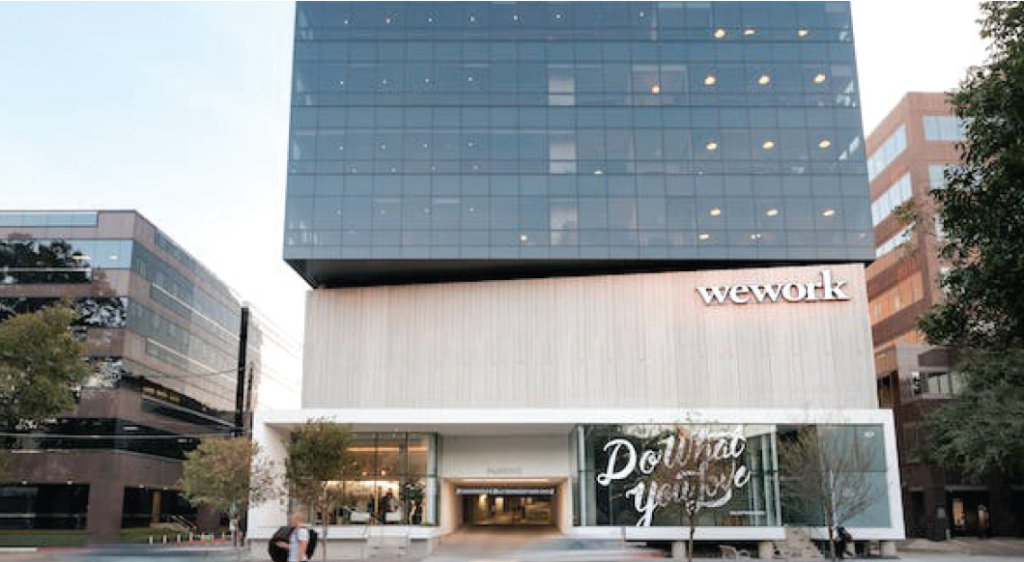Valued at a whopping $47 billion at one point, WeWork, the workplace real estate renter and one-time poster child of the effervescent startup culture is wobbling today. On the cusp of bankruptcy, today analysts are saying the same thing in one chorus. WeWork was one of the most hyped startups in recent years. Looking at the case of WeWork, analysts are wondering whether the startup bubble, the darling of modern-day corporate chivalry and the poster child for entrepreneurial genius, is about to fade into the history of vain startups.
By Jennifer Paldano Goonewardane.

WeWork office spaces.
Masayoshi Son, the founder of SoftBank, the majority shareholder of WeWork and one of its prolific backers convinced of its business model and growth potential, was quoted as saying that WeWork would be the “next Alibaba”. Towards that dream, he injected heaps of money into the startup. However, more than a decade after the promising startup made its debut and more t han five years a fter Son’s entry, t he company is yet to find the treasure in the cave despite receiving the “magic words” from investors who believed in its founder and team to make good on their promises.
The Fallacy of the Charismatic Leader
What is with startups and their founders who aid the wave of corporate revolution, new business models, and new thinking with excellent articulation, crowned and celebrated as models of hard work only to be dethroned and relegated to pariahs in the startup culture dustbin? The media elevated Elizabeth Holmes and Sam Bankman-Fried of FTX at their zenith and followed them with the same fervor as they fell from grace. These young innovators were dubbed the next Steve Jobs, the dropouts on their journey to make it big. Significant investors were throwing their weight behind them and elevating their star power. They were CEOs and founders in turtlenecks, attending speaking sessions with politicians in casuals, shorts, t-shirts, and sneakers.
With their fall comes off the facade. A flurry of news follows as prosecutors, investigators, and investors pursue them for justice and their pound of flesh. The magic evaporates. Their reputations descend to that of bullies and abusers who drank and smoked and led a toxic working environment. They become impersonators and charlatans who use other people’s money to live lavishly and pay themselves hefty cheques, feigning charisma, fooling investors, and enrapturing the public into believing in their enterprises. Young graduates listen in awe to their stories of resilience and grandiose plans for the future, hoping to learn a lesson or two from their journey. A better lesson would be to learn from their downfalls and know what not to do to get there.
The rise and fall of WeWork may have garnered less attention than other startups like Theranos and FTX. However, the story resonates well with the general trend in the startup ecosystem of limiting the story to a star individual and over-hyping the product beyond its potential. Part of the problem is often the founders themselves.
The WeWork arrangement suited even the established big corporates looking to set up in a new market, where its readymade office floor with all the facilities helped them set up shop without the hassle of organizing from scratch.
Impressive Rise but Problematic Founder
WeWork had an exciting and straightforward business model. Started in 2010 by Adam Neumann and Miguel McKelvey, the company organized co-working spaces by taking long-term leases of buildings, dividing them into smaller working areas, and subletting them to small businesses, startups and freelancers. As they touted, their product made working spaces affordable to individuals and companies unable to afford large office budgets. They made their unique proposition more appealing by creating sassy spaces that merged efficiency requirements with an ambiance that complimented the youthful and dynamic startup ecosystem with distinctive interiors with a range of facilities that a conventional workspace would afford. Their arrangements were flexible for clients wanting to make changes or expand their working areas to accommodate more people. At its pinnacle, WeWork seemed unstoppable, perched to be the next big startup wonder of the era.
Some significant backers in JPMorgan, Goldman Sachs and even Amazon supported its rise. However, its most prolific investor was the CEO of SoftBank, a vision fund, who, after a brief meeting with Neumann in 2017, had decided to invest $4.4 billion. As reported, at one point, WeWork had 847 locations spread across 123 cities worldwide. The company under Neuman expanded to include more ventures, rebranding itself as The We Company.
Since its meteoric rise from its launch in 2010, including Neumann landing on the Forbes front cover in October 2017 that hyped the new working order he founded, one of the next billion-dollar startups, the company never once turned in a profit despite billions of dollars in value.
The so-called simple business model, in operation, had mixed outcomes. For those who needed more capital to invest in office infrastructure and were unsure of their future direction and hence the size of the workforce and company, the WeWork model suited their circumstances. The WeWork arrangement suited even the established big corporates looking to set up in a new market, where its readymade office floor with all the facilities helped them set up shop without the hassle of organizing from scratch. The straightforward business model had its downsides, as pointed out by multiple analysts. It was a risky model that reacted to market volatility. The company had the power to leverage on full occupancy and increasing rents and not otherwise. In the case of WeWork, because it had rented enormous real estate on long-term leases, it still had to pay for them when occupancy reduced or when the real estate market tanked—sustaining their leased buildings during business downsides led to heavy cash outflows.
People who have followed the story of WeWork are pointing to its façade. First, it called itself a tech company, whereas it only sold office spaces equipped with technology its clients depend on to drive their ventures. Once heralded as the future of office spaces but constantly mired by downsides and strategic blunders, the period under Neumann from 2010 to 2019 was dominated by growth pursuits, an endeavor described as being pursued at all costs. Some attribute the company’s woes, continuing despite the ouster of its co-founder and CEO Neumann in 2019, to its aggressive expansion drive that naturally sent costs rocketing and putting the company in peril. The woes were of its own making. They were blunders as offshoots of their decisions. The company spent extensively creating appealing interiors in their shared workspaces, including giving free beer in some locations.
First IPO Attempt Exposes the Façade
Neumann became the focus in 2019 before his ouster when its first attempt at going public floundered. The first IPO attempt was the initial warning to investors about the actual goings-on in the company. With filings requiring substantial disclosures, they found that WeWork had made lavish projections for the market size of its business model. Naturally, potential investors raised concerns about the company’s path to profitability. Analysts point out that in being a long-term lessee who, as a short-term lessor, depended on revenue from short-term leasing, the company operated on shaky ground. The IPO filings disclosed the company’s losses, such as losing $5000 per new customer. In 2018, the year before its first IPO attempt, WeWork, with a revenue of $1.8 billion, incurred losses of $ 1.9 billion.
Meanwhile, the charismatic Neumann was wooing audiences with his unconventional attire, the barefoot CEO who traipsed the office casually in bare feet in a t-shirt and long hair. Neumann was ambitious and wanted ascendency fast, like most new entrepreneurs. He seemed infallible and invincible at his zenith. But Neumann was allegedly dipping too much into the company’s wallet on private jets and other spending sprees. With filed documents revealing the reality and with concerns raised, SoftBank, the company’s biggest shareholder, was seeking a delay in the IPO. SoftBank had a 31 percent stake in the company. Hence, any drop in value could result in SoftBank losing billions of dollars. By the third quarter of 2019, the value of WeWork had dropped to $5 billion, an 80 percent decline from the initial valuation made by the company. After the failed IPO, SoftBank lost over $10 billion, rescuing the company. As its majority shareholder, SoftBank has taken the beating for the failures of WeWork, with its founder Masayoshi Son at one point backing Neumann and his Eldorado to the hilt but later regretting his poor judgement.
The problem with Neumann was not only his lavish spending on parties, drinking and a jet but also a conflict of interest. Neumann borrowed from WeWork at low-interest rates to buy real estate, which, in turn, he had leased to WeWork. He was also selling his stocks in the company. Neumann also trademarked the name “We” and sold it back to the company, making millions of dollars out of it. He stepped down in the aftermath of the failed IPO and a slew of exposes, but not without walking away with $1.7 billion as the price for his exit.
New CEO Sandeep Mathrani had impressive real estate experience and came on board in early 2020 to turn the company around. But just as he took over, the COVID-19 pandemic engulfed the world and redefined hitherto working arrangements, forcing people to adapt and engage in remote work from their homes. Occupancy at their properties plummeted to 46 percent in 2020. As per their business model, their co-working clients were on short-term lease agreements, which meant that they did not return for renewal with the pandemic extending throughout the year and into 2021, forcing the company to start laying off employees, including letting go of some of its best underperforming properties and assets acquired during Neumann’s time, such as a private jet and selling off the subsidiaries that he had invested in through WeWork.
After the failed IPO, SoftBank lost over $10 billion, rescuing the company. As its majority shareholder, SoftBank has taken the beating for the failures of WeWork, with its founder Masayoshi Son at one point backing Neumann and his Eldorado to the hilt but later regretting his poor judgement.
Another IPO Attempt
These measures did help the company reduce costs by 2021. Encouraged by this outcome, the company launched its second bid at going public through a public purpose acquisition company (SPAC) merger. The valuation was $9 billion. Meanwhile, the company was losing money annually, estimated at more than a billion dollars. However, the new management argued that it had shed the encumbrances from Neumann’s conduct and the pandemic. Hence, it needed only 70 percent occupancy to break even on an adjusted EBITDA.
If the pandemic became the biggest challenge to its working model, the post-pandemic requirements became a pitching point for WeWork. COVID-19 re-wrote working arrangements, provided new meaning to working from home and demonstrated how remote working is possible and how companies could keep costs low by providing the infrastructure for employees to work remotely. Hence, the new order of a shortened work week of three days in the office and the rest remotely helped businesses to rent spaces and seats they only needed according to attendance. WeWork was offering the flexible spaces that the new working order demanded, and pundits were suddenly changing their tune to praise the WeWork model as ideal for the post-pandemic working requirements of accommodating small groups.
The SPAC arrangement helped the company raise $1.3 billion in new capital in the third quarter of 2021. The IPO valuation from the once staggering $47 billion had come down to $9 billion. Going public and raising new capital under a more prudent management team allowed WeWork to get back on track, including increasing its occupancy as the threat of the pandemic eased, reaching 73 percent occupancy in the first quarter of 2023, expanding the company’s contribution margin, indicating a reduction in overhead costs, while reducing its selling, general and administrative costs, a combination that helps drive a company towards profitability. In the fourth quarter of 2022, WeWork reported improvements to its contribution margin and general and administrative costs. These are two zones that the company had been fiercely grappling to rein in, with some previous quarters recording general and administrative expenses of over $200 million and negative contribution margins.
Continuing Downhill
However, the turnaround that was taking place at the end of 2022 following fresh capital infusion was not enough to stop the downward spiral, which some analysts point, apart from the external environmental factors concerning property valuations, could also be a result of the company losing its productivity in the process of cost-cutting. According to some reports, Extreme cost-cutting measures that included laying off staff could be impacting its overall performance. Hybrid working arrangements of the pandemic era continue to result in companies cutting costs for physical spaces, thereby impacting office property valuation. Compared to its revenue, the company’s general and administrative costs have remained high. Soaring operating expenses are impacting its revenues. In the first half of 2023, the company had spent $646 million. But the company reported an improvement in net losses at the end of the second quarter in 2023, a drop from $577 million last year to $349 million. At the end of the second quarter of 2023, the company had $205 million in hand.
The company has issued a going concern warning, a term used by companies expressing their doubts about their ability to cover expenses in the next year. A going-concern sign is a concern because it often foretells a company on the cusp of bankruptcy. The company has stated that it has “substantial doubts” about its ability to stay in business. In August, its share value plummeted below one dollar, exposing it to the possibility of being removed from the New York Stock Exchange. However, the company hopes to continue on a new trajectory, stating that amid tenant turnover, it will renegotiate for more favorable leases with landlords, focus on reducing rental costs, increase revenue and raise capital.
Substantial analysis has gone into studying the rise and fall of WeWork. While analysts are trying to point to specifics, a sequence of events and missteps, a lot of sugar coating and focusing on appearances to market its idea, which were, at best, marketing tools, rather than making a solid business case for the company. Analysts have pointed out that if the company thought that taking out Neumann when its initial attempt at going public failed in humiliation was enough, then that could explain the reason for its continuing saga of woes. Potential investors studying the company’s business model found that while the company had been running losses, the business model itself was unfeasible in the long term. Neumann liked pitching his company as a transformational technology company while operating in real estate. The company needed to address its key constituents convincingly. As a business model in a volatile industry, its executives had overlooked economic headwinds and their impacts and failed to account for them.
With the decline of WeWork, analysts are pondering on the problems with the startup ecosystem propelled by the rise of the Silicon Valley bubble that is demonstrating a boom-bust cycle, whether their founders are drowning in their unrealistic ideas, are prone to take too many risks and ill-judged decisions on spending, while also mismanaging and misallocating funds. In the case of WeWork, it was operating in a volatile market, which demanded a reactive and prepared mindset to changes and vigilance to market instabilities. WeWork wants to continue and resurrect itself. Hopefully, unlike Humpty Dumpty, someone will be able to put WeWork back together after the fall.

Miguel McKelvey, Co-founder, WeWork.

Adam Neumann, Co-founder, WeWork.





